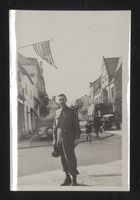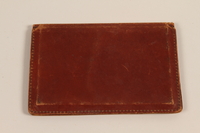Overview
- Brief Narrative
- US Army CIC identification shield used by Martin Dannenberg Jr., a Jewish American soldier awarded a Bronze Star for his wartime service. Martin was a Master Sergeant and Special Agent in Charge, 203rd Counter Intelligence Corps, attached to the III Corps, Third Army. By February 1945, he was in Germany with his unit. One of Martin's duties was to discover evidence for the planned war crimes trials. On April 27, 1945, an informant took Martin and his two man team to a bank vault in Eichstatt, where they discovered an original copy of the Nuremberg Race Laws, signed by Adolf Hitler. This decree was the foundation for the legal persecution of Jews in Germany. It excluded them from citizenship and identified Jews based on racial, not religious grounds. Anyone with 3 or 4 Jewish grandparents was classified a Jew, and marriage or sexual relations with Germans was illegal. Martin photographed the document inside the vault with a Minox Riga camera. The next day, he turned the Nuremberg Laws over to a member of General Patton’s staff, assuming they would be used as evidence in the trials. However, Patton kept them as a personal souvenir and gave them to the Huntington Library in 1945. The existence and provenance of the document was not known until 1999 when the Library lent them for display. In August 2010, the Library donated the document to the National Archives and Records Administration.
- Date
-
received:
1944 October
use: 1944 October-1945 May
- Geography
-
use:
France
use: Germany
- Credit Line
- United States Holocaust Memorial Museum Collection, Gift of Margery Dannenberg
- Markings
- holder, snap cap, engraved : RT / ?O / ? / ?
badge front, upper banner, engraved and painted, blue enamel paint : WAR DEPARTMENT
badge front, lower banner, engraved and painted, blue enamel paint : MILITARY INTELLIGENCE
badge back, center, engraved : C-224 - Contributor
-
Subject:
Martin E. Dannenberg Jr.
- Biography
-
Martin Ernest Dannenberg Jr. was born on November 15, 1915, in Baltimore, Maryland, to a Jewish couple, Martin Ernest (1891-1946) and Wilhelmina Wilfson (1889-1954) Dannenberg. He had a younger brother, Wilbur (1921-1935). His father Martin worked in the clothing business. His paternal grandparents were German immigrants. In 1842, his maternal great grandfather Charles Winternitz helped found the Har Sinai synagogue in Baltimore, the oldest Reform synagogue in the United States. Martin graduated from City College high school in 1931. He worked as a mail clerk at Sun Life Insurance Company and attended John Hopkins University and University of Baltimore’s Law School at night. On May 29, 1941, Martin married Esther Anne Salzman.
On December 8, 1941, following the attack on Pearl Harbor, the United States entered World War II. On August 20, 1942, Martin enlisted in the Army. He expessed interest in and was accepted into the Counter Intelligence Corps. After training, Martin was assigned to intelligence cases in the US. In August 1944, Martin, a Master Sergeant, shipped out from Boston to Normandy, France, arriving in September. He was a Special Agent in Charge, 203rd Counter Intelligence Corps Detachment, attached to the III Corps, Third Army, under General Patton. He fought in the Battle of the Bulge and reached Germany in early February 1945. One of Martin's duties was to discover evidence for the planned war crimes trials. In April, Martin apprehended a German official in Regensburg, who told Martin he knew the location of the Nuremberg Laws and would take him there if Martin returned him to Eichstatt. On April 27, the informant took Martin and his two man team to a farm near Eichstatt, where Hans Rauch, a Finance Ministry official, was hiding from the Gestapo. Rauch had been told to store the documents by the Waffen SS security chief and had placed them in a bank vault in Eichstatt. Rauch took Martin and his team to the bank vault, where Martin found the original texts of the Nuremberg Laws, as signed by Adolf Hitler, inside a manila envelope. They took photographs of the documents inside the vault. On April 28, Martin turned the document over to a member of General Patton’s staff, who gave it to General Patton. Martin thought the documents would be used as evidence in war crimes trials, but Patton kept them as a personal souvenir. In late April or early May, Martin was sent to investigate the recently liberated Dachau concentration camp. The war ended when Germany surrendered on May 7. Martin was awarded a Bronze Star for his service.
In May 1945, Martin returned to Baltimore, where he gave speeches about his war experience to his synagogue. Martin and Esther had three children. He continued working for Sun Life Insurance Company and eventually became chairman of the Board. After Esther’s death in 1989, Martin married Margery Singer Dopkin on October 21, 1990. Martin, age 94, died on August 18, 2010, in Baltimore. General Patton had given the Nuremberg Laws to the Huntington Library in Pasadena, CA, in June 1945. The existence and provenance of the document was not known until 1999 when the Library lent them for display. In August 2010, the Library donated the document to the National Archives and Records Administration.
Physical Details
- Language
- English
- Classification
-
Military Insignia
- Category
-
Badges
- Object Type
-
Badges (lcsh)
- Physical Description
- Small, rectangular, brown leather flap holder with a snap closure containing a gold painted metal badge pinned to an open ended leather square sewn across the center interior. The top of the shield shaped badge extends to form an eagle with cut outs below the outstretched wings. Embossed in the center of the shield is the seal of the US Department of the Army flanked by the letters U and S, with English text, a cuirass, a Phrygian cap, two flags, weapons, and the Roman numeral MDCCLXXVIII (1778) on a textured field. It has a raised border and banners with English text at the top and bottom. An engraved number and a pin and catch are on the back. A silver colored metal cable chain attached to the pin is then attached to a silver colored metal cocoon chain with a spring ring clasp looped through a hole in the leather case. The paint and leather are worn.
- Dimensions
- overall: Height: 2.500 inches (6.35 cm) | Width: 2.125 inches (5.398 cm) | Depth: 0.375 inches (0.953 cm)
- Materials
- overall : metal, enamel paint, paint, leather, thread
Rights & Restrictions
- Conditions on Access
- No restrictions on access
- Conditions on Use
- No restrictions on use
Keywords & Subjects
- Topical Term
- Jewish soldiers--United States--Biography. Espionage, American--Germany--Biography. Soldiers--United States--Biography. World War, 1939-1945--Secret service--United States--Personal narratives. World War, 1939-1945--Personal narratives, American.
- Corporate Name
- United States. Army. Counter Intelligence Corps
Administrative Notes
- Legal Status
- Permanent Collection
- Provenance
- The identification badge was donated to the United States Holocaust Memorial Museum in 2011 by Margery Dannenberg, wife of Martin Dannenberg and executor of his Estate.
- Funding Note
- The cataloging of this artifact has been supported by a grant from the Conference on Jewish Material Claims Against Germany.
- Record last modified:
- 2023-08-25 16:41:50
- This page:
- https://collections.ushmm.org/search/catalog/irn46849
Download & Licensing
In-Person Research
- By Appointment
- Request 21 Days in Advance of Visit
- Plan a Research Visit
- Request to See This Object
Contact Us
Also in Martin Dannenberg collection
The collection consists of a Minox B camera, an identification badge and holder, a wallet with credentials, documents, and photographs relating to the experiences of Martin Dannenberg during World War II, when he served in the Counter Intelligence Corps in the US Army.
Date: 1943-1960

Martin Dannenberg papers
Document
The Martin Dannenberg papers include Dannenberg’s Counter Intelligence Corps basic training materials, his records from an advanced security intelligence course, his motor vehicle operator’s permit, and photographs of Nuremberg and of Dannenberg with a fellow officer in the bank vault in Eichstatt where he recovered the original texts of the Nuremberg Laws, as signed by Adolf Hitler.

Leather document holder with CIC credentials used by a Jewish American soldier
Object
Leather wallet containing credentials used by Martin Dannenberg Jr., a Jewish American soldier awarded a Bronze Star for his wartime service. Martin was a Master Sergeant and Special Agent in Charge, 203rd Counter Intelligence Corps, attached to the III Corps, Third Army. By February 1945, he was in Germany with his unit. One of Martin's duties was to discover evidence for the planned war crimes trials. On April 27, 1945, an informant took Martin and his two man team to a bank vault in Eichstatt, where they discovered an original copy of the Nuremberg Race Laws, signed by Adolf Hitler. This decree was the foundation for the legal persecution of Jews in Germany. It excluded them from citizenship and identified Jews based on racial, not religious grounds. Anyone with 3 or 4 Jewish grandparents was classified a Jew, and marriage or sexual relations with Germans was illegal. Martin photographed the document inside the vault with a Minox Riga camera. The next day, he turned the Nuremberg Laws over to a member of General Patton’s staff, assuming they would be used as evidence in the trials. However, Patton kept them as a personal souvenir and gave them to the Huntington Library in 1945. The existence and provenance of the document was not known until 1999 when the Library lent them for display. In August 2010, the Library donated the document to the National Archives and Records Administration.



